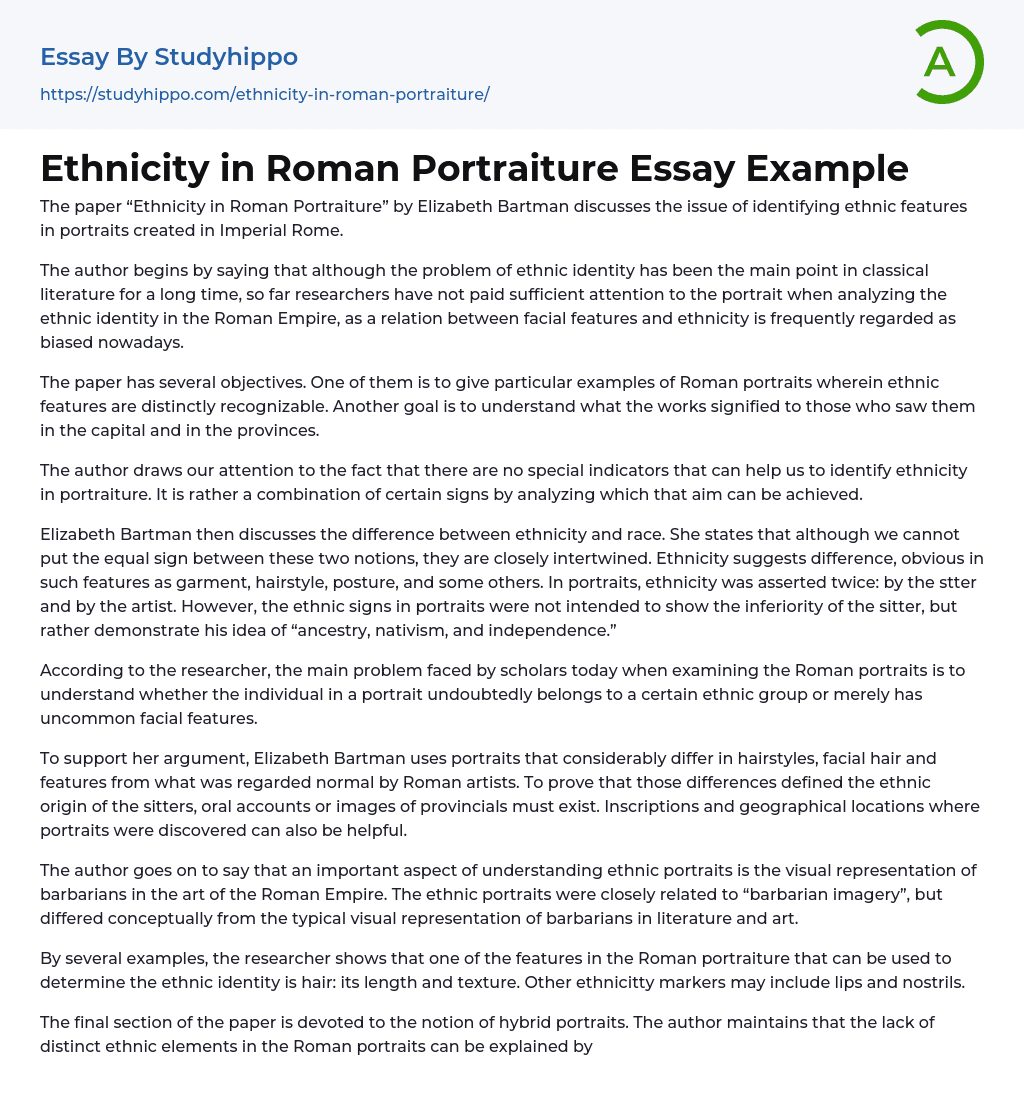The paper “Ethnicity in Roman Portraiture” by Elizabeth Bartman discusses the issue of identifying ethnic features in portraits created in Imperial Rome.
The author begins by saying that although the problem of ethnic identity has been the main point in classical literature for a long time, so far researchers have not paid sufficient attention to the portrait when analyzing the ethnic identity in the Roman Empire, as a relation between facial features and ethnicity is frequently regarded as biased nowadays.
The paper has several objectives. One of them is to give particular examples of Roman portraits wherein ethnic features are distinctly recognizable. Another goal is to understand what the works signified to those who saw them in the capital and in the provinces.
The author draws our attention to the fact that there are no special indicators that can h
...elp us to identify ethnicity in portraiture. It is rather a combination of certain signs by analyzing which that aim can be achieved.
Elizabeth Bartman then discusses the difference between ethnicity and race. She states that although we cannot put the equal sign between these two notions, they are closely intertwined. Ethnicity suggests difference, obvious in such features as garment, hairstyle, posture, and some others. In portraits, ethnicity was asserted twice: by the stter and by the artist. However, the ethnic signs in portraits were not intended to show the inferiority of the sitter, but rather demonstrate his idea of “ancestry, nativism, and independence.”
According to the researcher, the main problem faced by scholars today when examining the Roman portraits is to understand whether the individual in a portrait undoubtedly belongs to a certain ethnic grou
or merely has uncommon facial features.
To support her argument, Elizabeth Bartman uses portraits that considerably differ in hairstyles, facial hair and features from what was regarded normal by Roman artists. To prove that those differences defined the ethnic origin of the sitters, oral accounts or images of provincials must exist. Inscriptions and geographical locations where portraits were discovered can also be helpful.
The author goes on to say that an important aspect of understanding ethnic portraits is the visual representation of barbarians in the art of the Roman Empire. The ethnic portraits were closely related to “barbarian imagery”, but differed conceptually from the typical visual representation of barbarians in literature and art.
By several examples, the researcher shows that one of the features in the Roman portraiture that can be used to determine the ethnic identity is hair: its length and texture. Other ethnicitty markers may include lips and nostrils.
The final section of the paper is devoted to the notion of hybrid portraits. The author maintains that the lack of distinct ethnic elements in the Roman portraits can be explained by their social and political purpose. Many people in the provinces preferred to resemble the Romans in every detail. The sitter in a province almost adopted the “Roman way” with the exception of the facial features, garment, and hair typical of his native land. The final product can be characterized as a “hybrid”.
The members of provincial ruling classes required a “hybrid” portrait to represent two different cultural spheres: that of Rome and that of their own locality. Such approach was crucial for surviving politically. The Roman emperors entrusted the governing of the empire
to the local kings, who ordered their portraits to be made. Those images reflected the local elite’s desire to target two “audiences” simultaneously.
And that is the author’s principal argument. She claims that ethnic portraits show us that provincials chose to use some of the Roman manners, customs, and material objects, and projected them to their lifestyle. However, the sitters did not avoid showing their differences in the portraits in order to appear loyal to Rome. In that way, they also intended to ensure the support of their own subjects.
- Creativity essays
- Art History essays
- Theatre essays
- Pastoral essays
- Visual Arts essays
- Postmodernism essays
- Symbolism essays
- ballet essays
- Color essays
- Modernism essays
- Mona Lisa essays
- Work of art essays
- Body Art essays
- Artist essays
- Cultural Anthropology essays
- Ethnography essays
- Aesthetics essays
- Realism essays
- Heritage essays
- Harlem Renaissance essays
- Concert Review essays
- Voice essays
- Theatre Of The Absurd essays
- Playwright essays
- Scotland essays
- Tennessee williams essays
- Design essays
- Graffiti essays
- Graphic essays
- Typography essays
- Painting essays
- Photography essays
- Sculpture essays
- Architecture essays
- Interior design essays
- Arch essays
- Area essays
- Tattoo essays
- Pablo Picasso essays
- Vincent Van Gogh essays
- Michelangelo essays
- Frida Kahlo essays
- Ancient Rome essays
- Augustus essays
- Byzantine Empire essays
- Julius Caesar essays
- Roman Republic essays
- Mark Antony essays
- John Locke essays
- 9/11 essays




